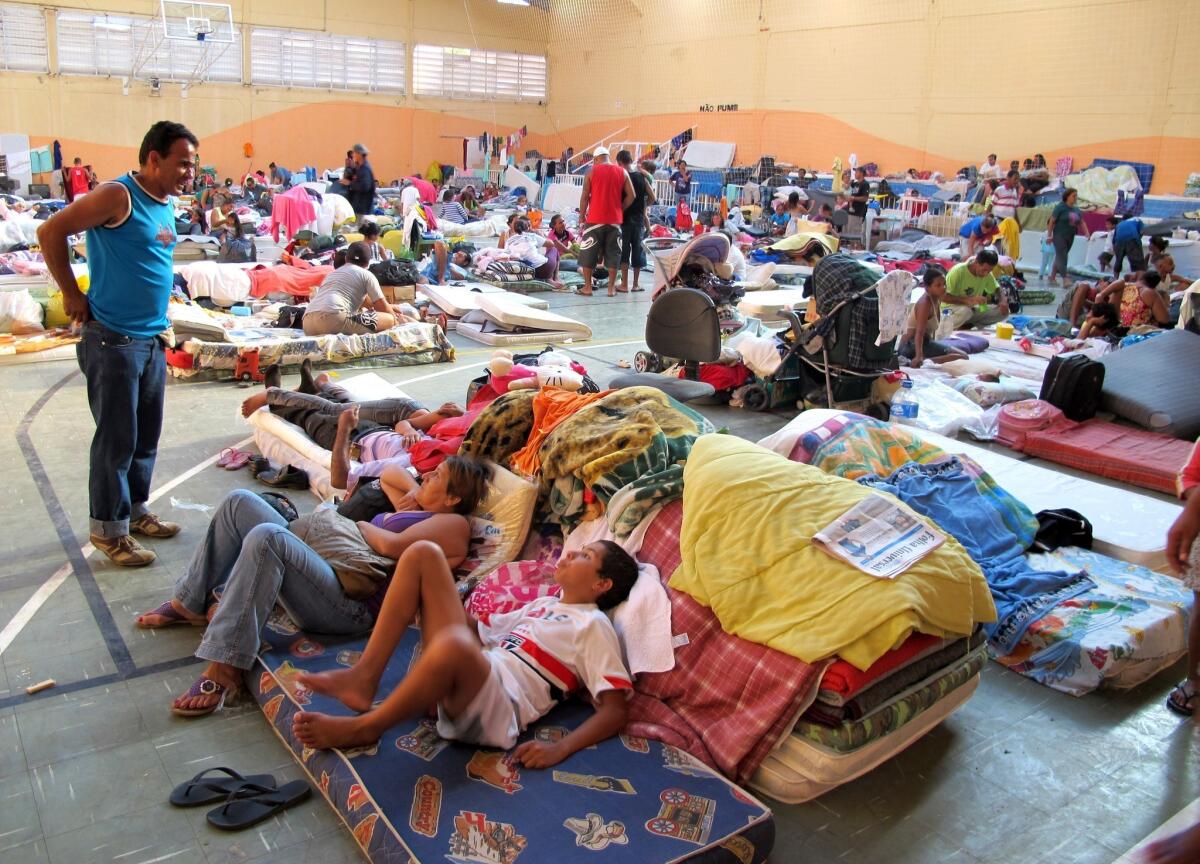In Brazil’s growth spurt, poor seem left behind

SAO JOSE DOS CAMPOS, BRAZIL -- Two children ran through the rubble, ducking under smoke pouring from a building that was still burning. Everywhere were signs that people had left in haste: toys, half-cooked meals, couches, ID cards, a fan photo of Justin Bieber.
The wasteland was the aftermath of a surprise raid by 1,800 police in riot gear, launched late last month on Pinheirinho, where 8,000 squatters had been living illegally since 2004. After clashing with residents and sympathizers armed with clubs and iron bars, the officers bulldozed the community.
Since then, Pinheirinho has become a smoldering symbol of the divide between Brazil’s haves and have-nots.
Over the last few years, the Brazilian economy has powered forward, pulling tens of millions out of poverty and creating a new middle class.
Indeed, just across the well-paved street from the wreckage of Pinheirinho is a strip mall that would be recognizable in Southern California.
Nearby Sao Paulo is now the most expensive city in the Western Hemisphere, surpassing New York and London.
Yet GDP per capita is still about a fourth of that in the United States. The minimum wage is less than $400 a month. And the violent razing of the Pinheirinho settlement -- seemingly to the benefit of real estate investors in Sao Jose dos Campos, a middle-class suburb -- brought a storm of criticism that some of the poor and marginalized are being cast aside in the race to profit from growth.
After the razing of Pinheirinho, Sao Paulo Mayor Gilberto Kassab was pelted with eggs, and a protest turned violent on the 458th anniversary of the city. Protesters were also taking issue with the way police have been aggressively clearing the homeless and drug-addicted from “Cracolandia,” or Crackland, a blighted section of the city’s center, to make way for urban redevelopment.
“It’s sad to find that what happened in Pinheirinho is not an isolated incident. It’s an expression of policy driven by real estate speculation,” Guilherme Boulos and Valdir Martins, activists involved in the Sao Paulo and Pinheirinho standoffs, wrote in a column in Folha de Sao Paulo, Brazil’s highest-circulation newspaper.
In another display of the backlash against the country’s runaway capitalist development, a radical movement has taken over Sao Paulo buildings in the last few months, some just blocks from Latin America’s largest stock exchange. Graffiti-covered walls and red flags hanging from windows serve as a jarring reminder to those working in the historic city center that not all of Brazil’s old inequalities have been resolved.
“We’re not asking for free housing,” said Maria de Fatima Simoes, a 48-year-old nurse speaking in one of the occupied buildings. “We’re asking for something affordable, and that the poor not be treated like criminals.”
Simoes, who left the building peacefully Thursday after a negotiated settlement with police, said she knew exactly where she would go with her special-needs son.
“We’ll go back to the streets,” she said. “Where do you think poor people go?”
When Luiz Inacio Lula da Silva became president in 2003, many here and abroad feared the leftist union leader might put the capitalist economy at risk or allow it to be overrun by radical movements, such as the Landless Workers Movement. After eight years of Lula’s rule, however, most economists agreed that he had successfully combined prudent policy with moderate social programs to ensure strong growth, and ended his presidency as one of the world’s most popular leaders.
Under his successor, Dilma Rousseff, who took over in January 2011, it is clear that most Brazilians continue to become better off materially, and Rousseff enjoys similarly high approval ratings. But for the first time in recent memory, new and old voices are emerging that say Brazil has erred too far on the side of growth.
Incomes and property values are rising, new consumers are spending more, and international investors are winning big returns. But investments in health, education and infrastructure have not kept up, economists say.
After the Pinheirinho razing, Gilberto Carvalho, an official in Rousseff’s administration, criticized the action, saying, “We think that there was still something that could have been done, above all a negotiated and humane exit for those families, without the need to create a battlefield in the location.”
The residents of the settlement, now sleeping on floors in community shelters or staying with relatives throughout Sao Jose dos Campos, knew they did not have legal title to the land. Many had hoped an agreement would be reached with the government to allow them to stay.
Some people said the Pinheirinho confrontation resulted from a combination of the destitute and those who wished to take advantage of a possible settlement for titles to valuable land.
“As with anything, you had your good and bad elements,” said Poliana Roman, a 48-year-old schoolteacher who lives near the razed slum. “Some moved in who had nothing, and others set up camp or built houses, then paid the truly poor to occupy their settlements or even rented them out to them.”
Eulalia Sousa Lopes, 32, was one of hundreds sleeping on the floor of a nearby gym with her daughter, Angela, until they could figure out where to go. “There is supposed to be some kind of a housing development, but after this, no one really trusts the authorities,” she said.
Minutes later, the power went out, plunging the sports complex into darkness.
“Well,” Sousa asked, “what can we do?”
--
Bevins is a special correspondent. Special correspondent Marina Consiglio contributed to this report
More to Read
Sign up for Essential California
The most important California stories and recommendations in your inbox every morning.
You may occasionally receive promotional content from the Los Angeles Times.










